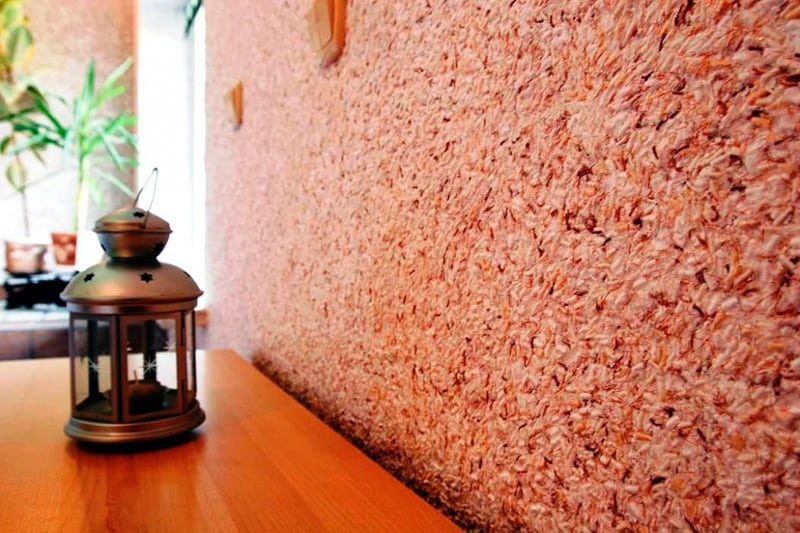Modern technologies and emerging, thanks to their use, new finishing materials allow us to solve issues that were previously considered insoluble. For example, turn ordinary wallpaper into washable with a significant extension of their service life. Today, for this it is enough to apply special varnishes for liquid wallpaper.
- What to look for when choosing a varnish
- Pros and cons of the technology in question.
- Processing technology

Despite the fact that this technology has not yet been widely disseminated, a number of significant advantages inherent in it should be pointed out.
What to look for when choosing a varnish
The varnish should be selected taking into account the type of coating applied to the wall. It should be remembered that each composition has its own physicochemical parameters and specific features of use.
- The application of a layer of varnish is carried out, most often, on wall coatings made using porous materials, for example, wallpaper made of non-woven fabric or paper. Vinyl wallpapers do not need varnishing, since their polymer coating initially has high moisture resistance.
- The most rare finish option is the use of nitro-varnishes for this purpose, since they include solvents that are very aggressive. Their direct contact with the surface of the wallpaper can lead to negative consequences for the latter. In the best case, there will be a change in the shades of the paint layer applied to them. At worst, the foundation itself may be damaged.
The most optimal solution when using nitro-varnishes is their application as a protective layer applied to wall coatings with a fine finish. But only after the layer of applied paint is completely dry. Nitro-lacquer is an excellent choice in cases where it is necessary to protect the wall bamboo mats from damage and premature wear.
- The best, to date, varnish for coating paper wallpapers is acrylic, water-based. It has a composition that is chemically neutral with respect to any pigments and does not damage the paper base of the wallpaper. The specified composition can be used when working with photo wallpaper without compromising the quality of their image.
To cover wallpaper from paper, it is better to use acrylic varnish. - If desired, the corresponding varnish solution can be made by yourself, using substances such as shellac and borax as the basis. The disadvantage of the mixture is its inherent dark background. What makes (if you have to work on light wallpaper) add to it an alcoholic solution of aromatic resin (sandrack). Or white pigment in small quantities.
- If you want to apply a protective layer of varnish to wallpaper made from cork, then preference can be given specifically to this purpose with intended materials, such as Lobadur, as well as any of its analogues. This will not lead to any decrease in the operational properties of coatings from raw materials that are natural.The cork allows its processing with acrylic varnishes. But at the same time, it loses most of its inherent vapor permeability and elasticity.
- Very popular is the use of varnish for liquid wallpaper. It is used not by application, but by the method of directly adding liquid wallpaper to the base before using it. Its presence after the completion of polymerization leads to a significant decrease in the moisture resistance of flax and cellulose fibers, which, in turn, protects the walls themselves from getting wet.
In addition to adding liquid wallpaper to the base, there is a variant of the traditional coating, i.e. application of surface varnishes (Poliver and analogues).
After the polymerization is complete, the visually indicated varnishes are practically not visible, so the wallpaper looks as usual.

Pros and cons of the technology in question.
Performing such a protective treatment, just like any other technology, has its advantages and disadvantages.
As the first we can mention the following:
- The applied varnish layer protects the liquid wallpaper from mechanical damage.
- After application, their moisture resistance increases.
- The presence of a varnish layer helps to maintain the brightness of the color of the wallpaper, including liquid, even with prolonged direct exposure to such a section of direct ultraviolet radiation.
The disadvantages include:
- The increase in the cost of finishing work.
- Applying a glossy layer of acrylic varnish on the wallpaper will make any unevenness of the wall in relief.
- A thin layer of trellis due to the penetration of varnish into it, can become virtually transparent. A preventive measure in this case may be the use of a variety of primers that fill all the pores in the wallpaper.
- Drying, the varnish partially changes the volume in the direction of reduction. This can lead to peeling of wallpaper that is torn at the joints, or disappear altogether if they were glued insufficiently.
Processing technology
Work is carried out step by step. And it all starts at the stage of gluing the wallpaper itself, which is carried out as follows:
- the base is prepared (primer, leveling);
- for gluing, glue corresponding to the type of trellis used is used;
- they are dried at optimal temperatures.
After drying, the wallpaper is treated with a colorless primer made on a PVA base. After that, acrylic varnish is applied in several layers. The application of the first layer is required to be done with a roller or a wide brush. Moving down the wall.
To give the wall a shine, it is required (after the varnish has completely dried) to polish the wall with a flannel. After polishing, the varnish is applied a second time. The varnish should dry at the optimum indicators of humidity in the room (≤ 80%) and temperature (5 - 30 degrees).
Re-polish the lacquered surface. During operation, such a surface does not need special care, as it has acquired antistatic properties.
Water-based varnishes, as well as nitro-lacquers, are quite effective in protecting trellis from mechanical damage and moisture penetration.






